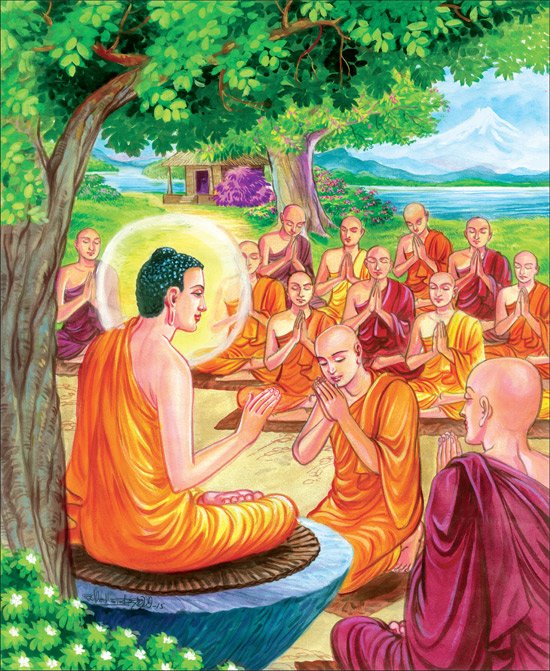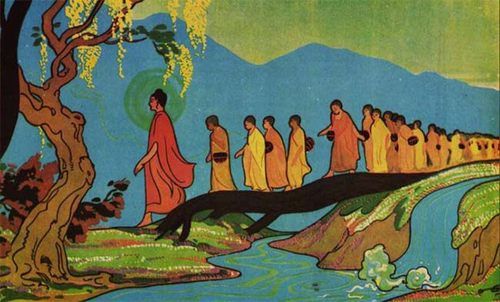
SECTION V-CAUSES OF THIS MISUNDERSTANDING
What the Buddha☸ preached was heard by his audience, which largely consisted of the Bhikkus.
It is the Bhikkus who reported to the people at large what the Buddha☸ had said on any particular matter.
1/12
What the Buddha☸ preached was heard by his audience, which largely consisted of the Bhikkus.
It is the Bhikkus who reported to the people at large what the Buddha☸ had said on any particular matter.
1/12

The art of writing had not yet developed.
The Bhikkus had therefore to memorize what they had heard.
Not every Bhikku cared to memorize what he heard.
But there were some who had made it their profession to memorize.
They were called Bhanakas.
2/12
The Bhikkus had therefore to memorize what they had heard.
Not every Bhikku cared to memorize what he heard.
But there were some who had made it their profession to memorize.
They were called Bhanakas.
2/12

The Buddhist canonical literature is as vast as ocean.
To memorize all this was indeed a great feat.
In reporting the Buddha☸ it has often been found that he has been misreported.
In reporting the Buddha☸ it has often been found that he has been misreported.
3/12
To memorize all this was indeed a great feat.
In reporting the Buddha☸ it has often been found that he has been misreported.
In reporting the Buddha☸ it has often been found that he has been misreported.
3/12

Reference may be made by way of illustration to five such cases.
One is mentioned in the Alagaddupama Sutta and the other in the Maha-Kamma-Vibhanga Sutta, a third in the Kannakatthala Sutta, fourth in the Maha-Tanha-Sankhya Sutta and fifth in the Jivaka
Sutta.
5/12
One is mentioned in the Alagaddupama Sutta and the other in the Maha-Kamma-Vibhanga Sutta, a third in the Kannakatthala Sutta, fourth in the Maha-Tanha-Sankhya Sutta and fifth in the Jivaka
Sutta.
5/12

There were perhaps many more such cases of misreporting.
For we find that even the Bhikkus going to the Buddha asking him to tell them what they should do in such contingencies.
The cases of misreporting are common with regard to karma and rebirth.
6/12
For we find that even the Bhikkus going to the Buddha asking him to tell them what they should do in such contingencies.
The cases of misreporting are common with regard to karma and rebirth.
6/12

These doctrines have also a place in the Brahminic religion consequently it was easy for the Bhanakas to incorporate the Brahminic tenets into the Buddhist Religion☸.
7/12
7/12

One has therefore to be very careful in accepting what is said in the Buddhist canonical literature as being the word of the Buddha☸.
There is however one test which is available.
8/12
There is however one test which is available.
8/12

☝🟢If there is anything which could be said with confidence it is:
He was nothing if not rational, if not logical.
Anything therefore which is rational and logical, other things being equal, may be taken to be the word of the Buddha☸.
9/12
He was nothing if not rational, if not logical.
Anything therefore which is rational and logical, other things being equal, may be taken to be the word of the Buddha☸.
9/12

✌🟢The second thing is that the Buddha☸ never cared to enter into a discussion which was not profitable for man’s welfare.
Therefore anything attributed to the Buddha☸ which did not relate to man’s welfare cannot be accepted to be the word of the Buddha☸.
10/12
Therefore anything attributed to the Buddha☸ which did not relate to man’s welfare cannot be accepted to be the word of the Buddha☸.
10/12

☝✌🟢There is a third test.
It is that the Buddha divided all matters into two classes.
Those about which he was certain and those about which he was not certain.
On matters which fell into class I, he has stated his views definitely and conclusively.
11/12
It is that the Buddha divided all matters into two classes.
Those about which he was certain and those about which he was not certain.
On matters which fell into class I, he has stated his views definitely and conclusively.
11/12

On matters which fell into class II, he has expressed his views.
But they are only tentative views.
In discussing the 3 questions about which there is doubt & difference it is necessary to bear these tests in mind before deciding what the view of the Buddha was thereon.
12
But they are only tentative views.
In discussing the 3 questions about which there is doubt & difference it is necessary to bear these tests in mind before deciding what the view of the Buddha was thereon.
12

• • •
Missing some Tweet in this thread? You can try to
force a refresh



























